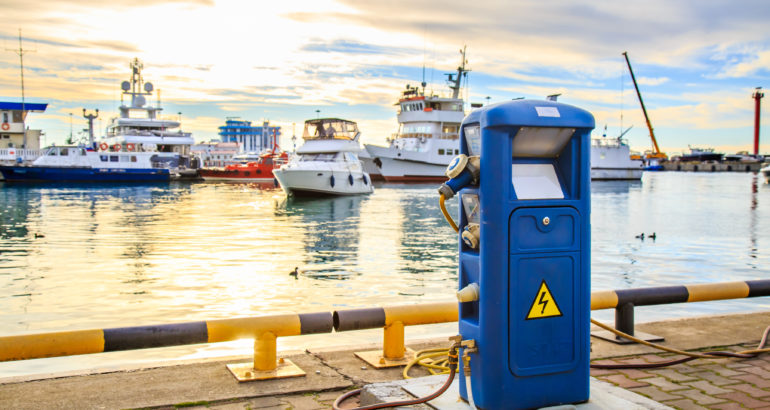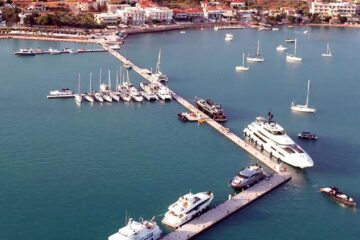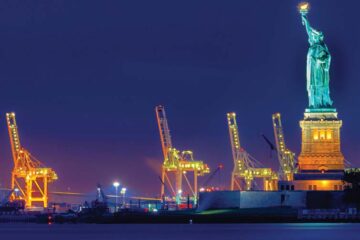With every Marina, when it comes to the dispensing of “Fuels”, safety is a major concern.
That being said, any fuel dispensing area should be located a sufficient distance from other structures to allow adequate room for safe ingress and egress of craft to be fueled. Dispensing units should be at least 25 feet from any activity not associated with the handling of fuel.
One should note that only approved dispensing units, with or without integral pumps, should always be used. Units may be located on open piers, wharves, floating docks, on shore, or on piers of the solid fill type.
Tanks and pumps not integral with the dispensing unit should be on shore or on a pier of the solid fill type and located above the maximum water level elevation.
In a situation where shore location would require excessively long supply lines to dispensers, the authority having jurisdiction may grant permission for installation of tanks on a pier. The quantity so stored should not exceed 1,100 gallons aggregate capacity.
Shore tanks supplying marine service stations may be located above ground where rock ledges, limited space, or a high water table make underground tanks impractical. All federal, state, and local regulations concerning aboveground storage tanks must be followed. In a situation where tanks are at an elevation that would produce gravity head on the dispensing unit, the tank outlet should be equipped with a pressure control valve positioned adjacent to and outside the tank block valve, and it should be adjusted so liquid cannot flow by gravity from the tank in case of piping or hose failure.
Piping between shore tanks and dispensing units should be as specified in Bulk Fuel Tank Storage Requirements, except that, where dispensing is from a floating structure, suitable lengths of oil-resistant flexible hose may be employed between the shore piping and the piping on the floating structure as made necessary by change in water level or shoreline.
A readily accessible and posted valve to shut off the fuel supply from shore should be provided in each pipeline at or near the approach to the pier and at the shore end of each pipeline adjacent to the point where flexible hose is attached.
Piping should be located so it is protected from physical damage. Corrosion protection for piping is also required.
Pipes that handle Class I liquids should be grounded to control stray currents.
Regarding the storage and handling of fuels, the fueling station should be located to minimize the exposure of all other plant facilities. Where tide and weather exposure conditions permit, all fuel handling should be outside the main berthing area.
Inside fueling stations should be located near an exit by water from the berthing area or at some other location from which, in case of fire aboard a boat alongside, the stricken craft may be quickly removed without endangering other boats or structures nearby.
When practical, fueling station docks, including the fuel system piping, should be detachable by means of quick disconnect systems that allow complete removal of the dock by pushing or towing it to a safe location should it catch fire, and piping disconnects that should prevent spillage of any fuel.
Dispensing units for transferring fuels from storage tanks should be in accordance with provisions of the Flammable and Combustible Liquids Code (NFPA No. 30). Every fuel delivery nozzle should be equipped with a self-closing control valve, which will shut off the flow of fuel when the operator’s hand is removed from the nozzle. THE USE OF ANY AUTOMATIC NOZZLE WITH A LATCH-OPEN DEVICE SHOULD BE PROHIBITED. In the construction of the fuel hose assembly, provisions should be made so the fuel delivery nozzle is properly bonded to the shore electric grounding facilities.
Fueling from cans should be discouraged.
Fuel pipes as well as connections and accessories should be readily accessible.
Fuel pipes should be adequately secured against excessive movement or vibration, protected from potential damage, and should have several piping disconnects with automatic shut-off valves in case the piping gets broken or separated.
Outlets for drawing gasoline below deck for any purpose should be prohibited.
When making up threaded pipe connections, an approved sealing compound, resistant to gasoline, should be used.
When making flared tube connections, it is essential that tubing be cut squarely and be truly flared by tools designed for those purposes.
Lastly, it is recommended that locations such as fueling stations, areas used for the storage and handling of fuel or other flammable liquids, boat storage sheds, paint and woodworking shops, sail lofts, battery charging rooms, boat locker rooms, and storage rooms, display the sign: “SMOKING AND OPEN FLAMES PROHIBITED.”
And finally…a means of extinguishing small fires quickly should at all times be readily available.









